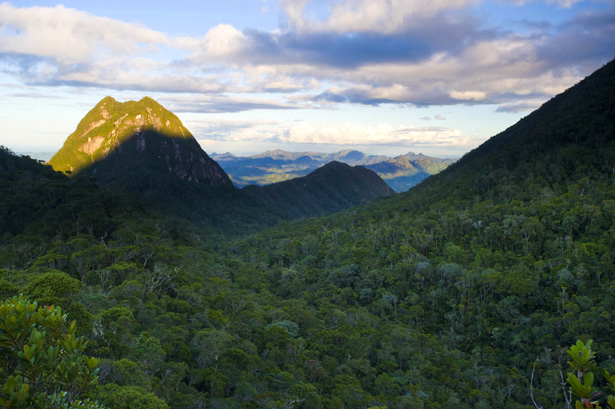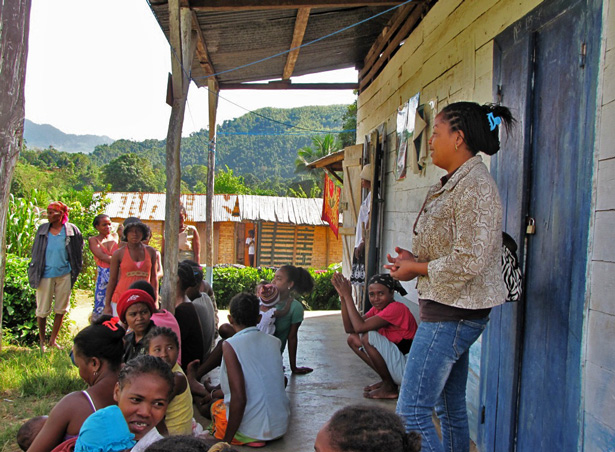-
After Chance Meeting, New Population, Health, and Environment Program Is Born in Madagascar
February 25, 2014 By Vik MohanAgainst the stunning backdrop of Marojejy National Park, I recently crossed paths with a conservationist from a very different background, working on the opposite side of Madagascar. But, it turns out, the communities we work with face many of the same challenges, and our meeting spawned a new population, health, and environment (PHE) program.
After an intense and productive visit to Blue Ventures’ PHE program in southwest Madagascar, where I serve as medical director, I was looking forward to my trip to Marojejy. Designated as part of a UNESCO World Heritage Site in 2007 for its immense biodiversity, high numbers of endemic species, and stunning mountain scenery, the park is rightly on Madagascar’s priority list for conservation. It’s also the location of the Duke Lemur Center’s new SAVA Conservation project.
The communities we work with face many of the same challenges.Based in Sambava, one of four cities in northeast Madagascar that make up the acronym in the project name, SAVA began in January 2012 and takes a multi-faceted community-based approach to biodiversity conservation with strong collaboration between a host of partners. Madagascar National Parks handles boundary demarcation and forest monitoring; Duke University provides undergraduate and graduate research on lemurs; Graine de Vie supports reforestation activities; CARE does training on yam and tarot agriculture; the local schools incorporate conservation into their curricula; Association Producteur Privee d’Aleyin Andapa gives freshwater fish farm training; and all of them work with the Antanetiambo Nature Reserve, one of the few protected areas created entirely by a local Malagasy resident.
Different But Similar Challenges
The night before my five-day trek into the park was to begin, I was fortunate enough to eat at a table adjacent to Erik Patel, world-renowned primatologist and director of SAVA. It wasn’t long before enthusiastic introductions were being made. Despite literally working in opposite parts of the country (Blue Ventures’ projects are in southeast Madagascar, SAVA in northeast) to conserve completely different ecosystems (coastal marine habitats vs. rainforest), I was instantly struck by the similarity of the challenges our respective organizations face.
A look at SAVA’s aquaculture efforts in Marojejy National Park Not least of the challenges faced by communities we partner with is poor health, and poor reproductive health in particular, largely resulting from a lack of access to family planning services. Fertility rates, along with maternal and infant mortality rates, are high in both areas. Madagascar is regressing in its progress towards, and is likely to miss, Millennium Development Goal 5 – to reduce maternal mortality by three quarters by 2015 and achieve universal access to reproductive health.
Working so closely with our respective partner communities, Erik and I have both directly witnessed the impact of this harsh reality. Quite apart from the huge health and social impact of high fertility rates on women and their families, women’s ability to engage in biodiversity conservation is limited, and the resulting population growth is one of the main drivers of unsustainable natural resource use that threatens biodiversity conservation efforts.
It wasn’t long before I realized that separately we had come to similar conclusions: An integrated approach, which addresses the needs of communities and threats to ecosystems, is likely to be the most effective way of meeting our conservation and development goals.
The Case for PHE
As someone who has spent a lot of time and energy extolling the virtues of this population, health, and environment approach to those who need a lot of persuading, witnessing Erik’s openness to incorporating voluntary family planning services into their project, and acknowledgement of the conservation as well as health benefits, was refreshing and exciting.
An integrated approach, which addresses the needs of communities and threats to ecosystems, is likely to be the most effective way of meeting our conservation and development goals.I didn’t need much encouragement to talk about Blue Ventures’ PHE program, and over subsequent days Erik and I discussed the details of family planning service provision and its integration into existing biodiversity conservation initiatives, ranging from the details of different contraceptive options to different methods of service delivery, integrated education, and the importance of maintaining a rights-based approach. Having delivered PHE training to partner organizations in the past, we also touched on follow-up support that Blue Ventures could provide.
These conversations were interspersed with visits to the impressive portfolio of projects that SAVA supports around the national park, from conservation education to aquaculture, reforestation, and lemur research. Once again I was struck by how the Duke Lemur Center’s approach so closely mirrors that of Blue Ventures: a frank appraisal of the range of threats to biodiversity conservation and a willingness to pioneer, test, and implement community-based solutions.
Rapid Implementation
At the end of my stay, as luck would have it, we were booked to fly back to Antananarivo together, allowing us to continue the conversation, and in the months to follow Erik quickly laid the foundation for fruitful partnerships.

A Marie Stopes nurse discusses family planning options with residents of Belaoka Lokoho, near Marojejy National Park (Lanto Andrianandrasana) I connected Erik with our health partners, Population Services International and Marie Stopes Madagascar, and SAVA began hosting “Marie Stopes Ladies” – nurses and midwives trained to provide family planning services in remote areas – in Marojejy. So far, nearly 100 women in several villages adjacent to the park have received long-acting reversible contraceptive implants, which provide up to three years of continuous contraception. By all accounts, community interest has been tremendous, with many women walking long distances to receive information and counselling about the range of contraceptives available to them. Many are very young mothers (some only 14 years old) who have expressed difficulty in accessing family planning services in the past.
Learning about SAVA’s inspiring work and witnessing how rapidly and effectively they have managed to facilitate improved provision of family planning services into their existing efforts – with no additional resources! – has filled me with immense hope for the future of Madagascar and PHE in general.
I’ve sensed growing interest in exploring the potential for integrated programming in many informal conversations with health and conservation partners, but this was the first time it resonated so immediately. If a chance meeting like this can yield such exciting results, imagine the impact of a more systematic and nation-wide effort to promote more interdisciplinary development and conservation.
PHE is once again making waves in Madagascar, and the waves are gathering momentum!
Vik Mohan is a practicing doctor in the UK, founder of Blue Ventures’ community health program, and architect of Blue Ventures’ PHE approach.
Photo Credit: View of Marojejy National Park, used with permission courtesy of Iñaki Relanzon/SAVA Conservation; A Marie Stopes nurse speaks to residents of Belaoka Lokoho, used with permission courtesy of Lanto Andrianandrasana/SAVA Conservation. Video: “Promoting Native Freshwater Fish Farming,” courtesy of DLC SAVA Conservation Videos.
 A Publication of the Stimson Center.
A Publication of the Stimson Center.





